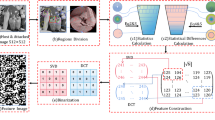Abstract
In this paper, we proposed a novel zero- watermarking method using the compressed sensing (CS) significant feature. The original image is segmented into non-overlapping blocks and then constructs a scrambled block Hadamard ensemble (SBHE) matrix as a sensing matrix to sense every block. CS significant feature can be represented by the sum of each block’s measurements. Then each pixel value of the binary zero-watermark is embedded by modifying the CS significant features. At last zero-watermark is registered, and the sensing matrix is stored as extra key. With the CS significant feature, the robustness of the zero-watermarking algorithm can be greatly improved. SBHE matrix can reduce the computational complexity of the compressed sensing and also reduce storage costs. In addition, because of the randomness of SBHE matrix, the proposed zero-watermarking method can provide excellent confidentiality. Moreover, our algorithm is different from the traditional zero-watermarking methods with pure meaningless image features, copyright holders can be legally recognized by the identity’s image which is embedded into the zero-watermark, so the authentication process of the zero-watermark is more intuitive and convenient.








Similar content being viewed by others
References
Chao JIA, Zhang Z-H (2013) A digital image zero-watermarking algorithm based on SURF and normalization. Comput Technol Dev 4:144–147
Chen H, Luo T, Yu M (2011) A zero-watermark method based on texture characteristic of image blocks for stereo images. AJER 11(12):1617–1620
Davenport M (2013) “The Fundamentals of Compressive Sensing”. IEEE SPEL
Donoho DL (2006) Compressed sensing. IEEE T Inform Theory 52(4):1289–1306
Fan L, Gao TG, Yang QT (2010) A novel zero-watermark copyright authentication scheme based on lifting wavelet and Harris corner detection. Wuhan Univ J of Nature Science 15(5):408–414
Gan H, Xiao S, Zhao Y, Xue X (2018) Construction of efficient and structural chaotic sensing matrix for compressive sensing. Signal Process Image Commun 68:129–137
Gan L, Do TT, Tran TD (2008) Fast compressive imaging using scrambled block hadamard ensemble. Proc, EUSIPCO
Hao S, Zhu X, Zhu G, Li G (2014) A robust zero-watermarking scheme for image based on block compressive sensing and Arnold transformation. J Inform Comput Sci 11:2505–2516
Hu C, Wang X (2009) “Zero watermark protocol based on time-stamp and digital signature.” IFITA. 193–196
Hu MY, Tian XL and Xia SW (2011). Robust Digital Image Zero-watermarking Based on CDMA Technology. 4th CISP. 1035–1038
Jing L, Li SH (2007) Robust Zero-watermarking scheme using local invariant keypoints. Proceed Int Conf on Multimedia Syst Signal Process (IEEE. Computer Society Press, Hangzhou. 39–44.
Jing L, Liu FL (2007) Double zero-watermarks scheme utilizing scale invariant feature transform and log-polar mapping. Proceed IEEE Int Conf Multimedia Expo (IEEE Computer Society, Beijing):2118–2121
Lang J, Zhang ZG (2014) Blind digital watermarking method in the fractional Fourier transform domain. Opt Laser Eng 53:112–121
Liu C, Sun J, Zhang Y, Liu W (2019) Robust zero watermarking algorithm based on singular value decomposition. J Liaoning Techn Univ 38(4):372–376
Liu JJ, Tao L (2012) Robust image zero-watermarking using non-negative matrix factorization. Comput Eng Appl 48:90–93
Mayiami M, Seyfe B, Bafghi H (2013) Perfect secrecy via compressed sensing. Iran Workshop Commun Inform Theory 1-5
Orsdemir A, Altun H, Sharma G, Bocko M (2008) On the security and robustness of encryption via compressed sensing. IEEE Milit Commun Conf:1–7
Rachlin Y, Baron D (2008) The Secrecy of Compressed Sensing Measurements. 46th Ann Allerton Conf Commun, Control Comput. 813–817
Rahmani H, Mortezaei R, Moghaddam ME (2010) “A new lossless watermarking scheme based on DCT coefficients.” The 6th IDC. 28–33
Rawat S, Raman B (2012) A blind watermarking algorithm based on fractional Fourier transform and visual cryptography. Signal PR 92(6):1480–1491
S Z, Kintak U (2017) A novel image zero-watermarking scheme based on non-uniform rectangular. Proceed Int Conf Wavelet Anal Patt Recogn:78–82
Sang J, Liao X, Alam MS (2006). “Neural-network-based zerowatermark scheme for digital images,” Opt. Eng. 45(9), 097006–1–097006-9
Wen Q, Sun T, Wang S (2003) Concept and application of zero-watermark. Acta Electron Sin 31:214–216
Yang K, Wang W, Yuan Z, Zhao W (2018) Strong robust zero watermarking algorithm based on NSCT transform and image normalization. IEEE 3rd Advanced Information Technology, Electronic and Automation Control Conference (IAEAC 2018), pp, 236–240
Ye TY, Ma ZF, Niu XX, Yang YX (2010) A zero-watermark technology with strong robustness. J Beijing Univ Posts Telecomm 33(3):126–129
Yu NY (2017) On the security of compressed encryption with partial unitary sensing matrices embedding a secret keystream. EURASIP J Adv Signal Process 2017(1):73
Zhang L, Cai P, Tian XL and Xia SW (2011) A novel zero-watermarking algorithm based on DWT and edge detection. 4th CISP. 1016–1020
Zhao CH, Liu W (2012) Mutual support dual watermark algorithm based on compressive sensing. Acta Electron Sin 40(4):681–687
Acknowledgements
The authors would like to thank the anonymous reviewers for their great efforts and valuable comments that are greatly helpful to improve the clarity and quality of this manuscript. Special thanks are also due to the instrumental and data analysis from Analytical and Testing Center, Northeastern University. This work was supported by “985 Project” of Northeastern University (No. 985-3-DC-F24), National Natural Science Foundation of China (No. 61202446), and Fundamental Research Funds for the Central Universities (N150404004).
Author information
Authors and Affiliations
Corresponding author
Ethics declarations
Conflict of interests
The authors declare that they have no known competing financial interests or personal relationships that could have appeared to influence the work reported in this paper.
Additional information
Publisher’s note
Springer Nature remains neutral with regard to jurisdictional claims in published maps and institutional affiliations.
Rights and permissions
Springer Nature or its licensor holds exclusive rights to this article under a publishing agreement with the author(s) or other rightsholder(s); author self-archiving of the accepted manuscript version of this article is solely governed by the terms of such publishing agreement and applicable law.
About this article
Cite this article
Lang, J., Ma, C. Novel zero-watermarking method using the compressed sensing significant feature. Multimed Tools Appl 82, 4551–4567 (2023). https://doi.org/10.1007/s11042-022-13601-9
Received:
Revised:
Accepted:
Published:
Issue Date:
DOI: https://doi.org/10.1007/s11042-022-13601-9




